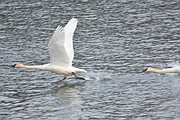Majestic tundra swans visit Boundary County
“Hear the music, the thunder of wings. Love the swan.” — Robinson Jeffers
During early April you can expect to see swans, ducks and geese. You can stop at one of the pullouts beside the many lakes or ponds in Boundary County and listen to the gabble of waterfowl from your car. Don’t forget to take binoculars, a spotting scope and a camera and plan to enjoy watching and listening to these magnificent birds.
April is here and swans have returned to the ponds of North Idaho. Last week the ponds at the Kootenai National Wildlife Refuge hosted 30-40 tundra swans and the Boundary Creek Wildlife Management area hosted more than 200 tundra swans and several hundred ducks and geese. The ponds of North Idaho are alive with quacks, honks whistles, wing flapping and birds anxious to head north.
Boundary County is a major stop over for tundra swans headed north. Joining the swans is a delightful variety of migrating ducks and geese.
Tundra swans are magnificent birds; they have 6-7 foot wingspans and weigh 12-15 pounds. The magnificent, normally cold-loving tundra swan is large and vigorous. The adult has pure white plumage, a jet-black bill and feet, a long neck, and powerful wings. Highly gregarious, these swans migrate and overwinter in flocks.
These are the flying mega fortresses of the bird world. Big, strong and tough, they fly thousands of miles each year. Most are returning from the Central Valley of California. They move north as the ice comes off ponds and lakes.
The only waterfowl bigger than the tundra swan is the trumpeter swan; which can weigh up to 30 pounds and is the biggest flying bird in the world.
Within the flock; whether in the air or on the ground, tundra swans maintain tight family bonds. Not only do mated adults stay loyal for life; they teach and protect their offspring through the young swans’ first migration and winter. Juvenile tundra swans have variably gray heads and upper necks.
On the water trumpeter and tundra swans are very hard to tell apart until you hear them sound off. A flock of trumpeters sounds like an orchestra warming up. Tundras have deep, almost goose-like sounds that bounce off the water and is often mistaken for the Canada geese.
I remember sitting in my Jeep on the road at the Boundary County Wildlife Management Area at the extreme north end of Boundary County and listening to more than 300 tundra swans last week. Their voice is the matrix binding the swans together. They chattered among themselves while standing, while feeding, and even while roosting.
When flying together — in strong V formations high overhead or in straight lines within a few hundred feet off the ground — Tundra swans are often heard by humans before they are seen. Check for a shiver of bone-deep thrill if you experience this. The swan’s distinctive call — one to three flutey syllables, oo oh oo — pierces the spring air.
One thing I notice when watching the tundra swans: they are strong swimmers and can take off from the water with a running start and beat their wings until airborne. Their flapping wings produce a sound that earned them the name “whistling swan.”
All bird watchers enjoy the springtime show. Tundra swans and Canada geese ignore bird watchers as they go through spring courtship rituals. They preen, chase other swans and geese away from their partners, and go through a series of neck stretches and wing flapping to stake out their mate and the territory around them. It is a great show!
Enjoy the beauty of Boundary County!



